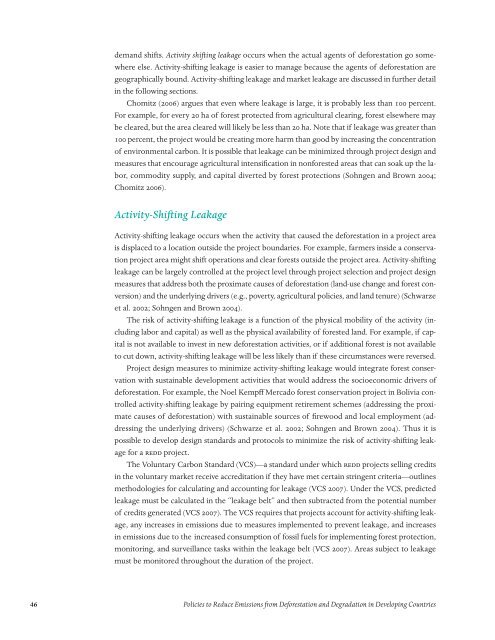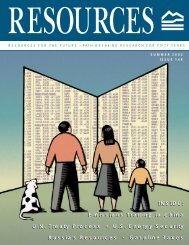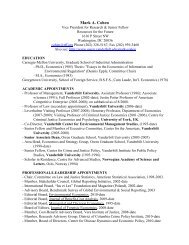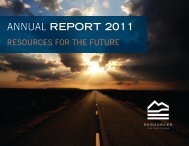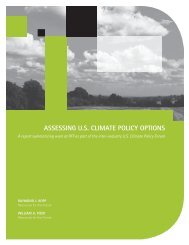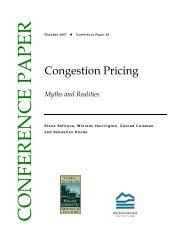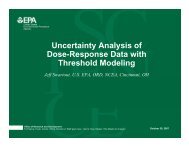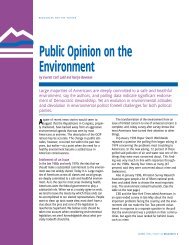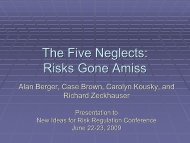Policies to Reduce Emissions from Deforestation and Degradation ...
Policies to Reduce Emissions from Deforestation and Degradation ...
Policies to Reduce Emissions from Deforestation and Degradation ...
Create successful ePaper yourself
Turn your PDF publications into a flip-book with our unique Google optimized e-Paper software.
dem<strong>and</strong> shifts. Activity shifting leakage occurs when the actual agents of deforestation go somewhere<br />
else. Activity-shifting leakage is easier <strong>to</strong> manage because the agents of deforestation are<br />
geographically bound. Activity-shifting leakage <strong>and</strong> market leakage are discussed in further detail<br />
in the following sections.<br />
Chomitz (2006) argues that even where leakage is large, it is probably less than 100 percent.<br />
For example, for every 20 ha of forest protected <strong>from</strong> agricultural clearing, forest elsewhere may<br />
be cleared, but the area cleared will likely be less than 20 ha. Note that if leakage was greater than<br />
100 percent, the project would be creating more harm than good by increasing the concentration<br />
of environmental carbon. It is possible that leakage can be minimized through project design <strong>and</strong><br />
measures that encourage agricultural intensification in nonforested areas that can soak up the labor,<br />
commodity supply, <strong>and</strong> capital diverted by forest protections (Sohngen <strong>and</strong> Brown 2004;<br />
Chomitz 2006).<br />
Activity-Shifting Leakage<br />
Activity-shifting leakage occurs when the activity that caused the deforestation in a project area<br />
is displaced <strong>to</strong> a location outside the project boundaries. For example, farmers inside a conservation<br />
project area might shift operations <strong>and</strong> clear forests outside the project area. Activity-shifting<br />
leakage can be largely controlled at the project level through project selection <strong>and</strong> project design<br />
measures that address both the proximate causes of deforestation (l<strong>and</strong>-use change <strong>and</strong> forest conversion)<br />
<strong>and</strong> the underlying drivers (e.g., poverty, agricultural policies, <strong>and</strong> l<strong>and</strong> tenure) (Schwarze<br />
et al. 2002; Sohngen <strong>and</strong> Brown 2004).<br />
The risk of activity-shifting leakage is a function of the physical mobility of the activity (including<br />
labor <strong>and</strong> capital) as well as the physical availability of forested l<strong>and</strong>. For example, if capital<br />
is not available <strong>to</strong> invest in new deforestation activities, or if additional forest is not available<br />
<strong>to</strong> cut down, activity-shifting leakage will be less likely than if these circumstances were reversed.<br />
Project design measures <strong>to</strong> minimize activity-shifting leakage would integrate forest conservation<br />
with sustainable development activities that would address the socioeconomic drivers of<br />
deforestation. For example, the Noel Kempff Mercado forest conservation project in Bolivia controlled<br />
activity-shifting leakage by pairing equipment retirement schemes (addressing the proximate<br />
causes of deforestation) with sustainable sources of firewood <strong>and</strong> local employment (addressing<br />
the underlying drivers) (Schwarze et al. 2002; Sohngen <strong>and</strong> Brown 2004). Thus it is<br />
possible <strong>to</strong> develop design st<strong>and</strong>ards <strong>and</strong> pro<strong>to</strong>cols <strong>to</strong> minimize the risk of activity-shifting leakage<br />
for a REDD project.<br />
The Voluntary Carbon St<strong>and</strong>ard (VCS)—a st<strong>and</strong>ard under which REDD projects selling credits<br />
in the voluntary market receive accreditation if they have met certain stringent criteria—outlines<br />
methodologies for calculating <strong>and</strong> accounting for leakage (VCS 2007). Under the VCS, predicted<br />
leakage must be calculated in the “leakage belt” <strong>and</strong> then subtracted <strong>from</strong> the potential number<br />
of credits generated (VCS 2007). The VCS requires that projects account for activity-shifting leakage,<br />
any increases in emissions due <strong>to</strong> measures implemented <strong>to</strong> prevent leakage, <strong>and</strong> increases<br />
in emissions due <strong>to</strong> the increased consumption of fossil fuels for implementing forest protection,<br />
moni<strong>to</strong>ring, <strong>and</strong> surveillance tasks within the leakage belt (VCS 2007). Areas subject <strong>to</strong> leakage<br />
must be moni<strong>to</strong>red throughout the duration of the project.<br />
4 <strong>Policies</strong> <strong>to</strong> <strong>Reduce</strong> <strong>Emissions</strong> <strong>from</strong> <strong>Deforestation</strong> <strong>and</strong> <strong>Degradation</strong> in Developing Countries


